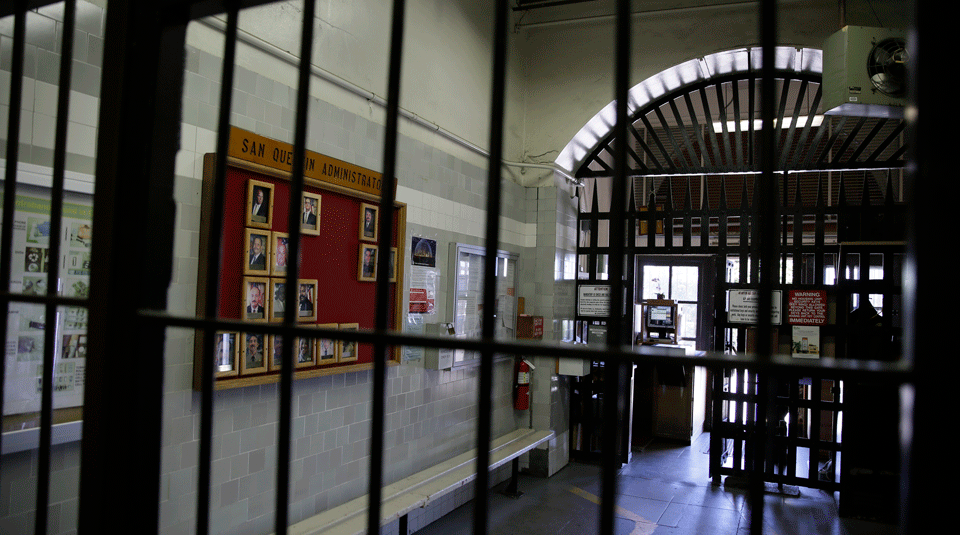
OAKLAND, Calif.—One of COVID-19’s most dramatic consequences in California has been its impact on the state’s prison population. As of July 8, nearly 2,300 of the 115,000 people incarcerated in the state’s historically overcrowded prison system had tested positive for the disease, and at least 31 had died. Over 600 prison workers have also tested positive.
Protesters have repeatedly demanded massive reduction of prison populations, and legislators and elected officials have added their voices to the rising calls for sweeping changes both in the handling of the pandemic and in the prison system generally.
A study last year by the Public Policy Institute of California found that African-American men are imprisoned in the state’s prison system at 10 times the rate of their white counterparts, and African-American women at five times the rate of white women. Latinx men and women are also overrepresented but not so dramatically.
The pandemic has taken its heaviest toll at San Quentin State Prison in Marin County, north of San Francisco, where over one-third of the over 4,000 men incarcerated there have tested positive for the virus and at least six have died. More than 180 staff have also become ill.
The outbreak was ignited May 30 when 121 men were transferred to San Quentin from the California Institute for Men in Chino, east of Los Angeles, which had experienced a surge in infections. Though the men had been tested for COVID-19 before departing, it was later revealed that the tests were done two to four weeks earlier, and after they reached their destination, 25 tested positive.
Before the transfer, no cases had been reported at San Quentin. With crowding ruling out social distancing, and with many men housed in old-style five-tiered cell blocks with bars allowing air to circulate widely, infections began to soar.
In a four-hour virtual hearing July 1, the California Senate Committee on Public Safety heard testimony by Ralph Diaz, secretary of the California Department of Corrections and Rehabilitation, and J. Clark Kelso, who has served since 2008 as federal receiver for California Correctional Health Care Services, which provides medical services in the state prison system.
The committee also heard advocates for the rights of incarcerated people, including leaders of organizations demanding radical improvement of health conditions within the prisons and large-scale releases to cut the prison population by at least half. Also testifying: public health experts, workers at San Quentin, legal advocates for prisoners’ rights, and the Chief Public Defender of nearby Alameda County.
Though he largely upheld its response to the pandemic, Diaz acknowledged that his department has experienced “setbacks,” including the massive San Quentin outbreak. He cited achievements such as CDCR’s halting of in-person visits and transfers from county jails, making personal protective equipment more available, increasing cleanings inside prisons, increasing testing, and slowly lowering the prison population. He also defended CDCR’s policy of handing people over to Immigration and Customs Enforcement (ICE) on their release from prison if they also faced immigration charges.
Diaz declared, “We can do better, and I know we will do better. But I need to express that we’ve also had successes.”
Kelso publicly confirmed that the men transferred from Chino had not been tested for up to four weeks before they were moved at the end of May. While testing was required before transfer, he said, an appropriate time period was not specified.
Kelso told the committee members, “I’ve been involved from Day One … in all COVID matters. I’m accountable and responsible both for the successes and for the failures.”
Calling the transfer “abhorrent,” the Public Safety Committee’s chair, State Sen. Nancy Skinner, D-Berkeley, questioned how people who hadn’t been recently tested could have been moved. And when officials asserted they had released some 8,000 from the prison system since the pandemic started, Skinner said that just represented a normal number of releases.
Assemblymember Marc Levine, D-San Rafael, who also participated in the hearing, denounced the transfer as “the worst prison health screw-up in state history.”
On the Sunday before the hearing, hundreds of protesters from the Oakland-based Ella Baker Center for Human Rights, along with family members, interfaith groups, and formerly incarcerated people had gathered near San Quentin. Among their demands: mass release of the incarcerated, no transfers between prisons during the pandemic, no more cooperation with ICE, adequate testing of those incarcerated, and adequate PPE and hygiene products.
Days later, Ella Baker Center staff member James King—himself incarcerated at San Quentin until about six months ago—told the Senate committee about conditions inside the prison.
Nearly 800 men occupied a building designed for 400, sharing 18 showerheads and 12 pay phones, King said. “The building was poorly ventilated, the windows are welded shut, the cells have bars instead of doors, cells 4’ x 9’ have two people living in them … The only responsible solution is large-scale releases. But despite reports to the contrary, releases have actually slowed down.”
King’s concerns were echoed by Dr. David Sears, associate professor of medicine at the University of California, San Francisco and a participant in UCSF’s AMEND, which works to transform correctional culture and lessen incarceration’s negative health consequences.
Besides building a centralized emergency response team, and protecting and supporting prison staff, Sears said AMEND recommends cutting San Quentin’s population “to at least 50% of current capacity” to make physical distancing, testing to isolate cases, and quarantining exposed people possible.
“It is incumbent on all of us to respond immediately, proactively,” he said, “to address this tragedy and to prevent it from unfolding again and again throughout the state.”
Karen Franklin, a vocational nurse at San Quentin and member of SEIU Local 1000, gave a harrowing account of nurses reusing gowns and masks “over and over again,” using garbage bags as gowns, and pulling N95 masks out of hazmat bags and cleaning them with disinfectant wipes before reusing them. On a more hopeful note, Franklin expressed great appreciation for substantial improvements in PPE during the week before the committee hearing.
Alameda County’s Chief Public Defender Brendon Woods described his efforts to communicate with Gov. Gavin Newsom and Secretary Diaz about the situation at San Quentin. His recommendations included immediate release of the elderly and medically vulnerable and those with one year left to serve, as well as planning for early release of those with three years remaining in their sentences.
Woods said some 10,000 people had signed onto those recommendations since his office launched a petition to the governor June 26, with many people signing for their organizations. The petition was delivered to the governor July 1. Among signers: public defender offices in 14 counties, the American Civil Liberties Union, and more than 20 legal and community organizations.
Among this week’s developments:
- At a July 6 press conference, Gov. Newsom said the state is planning to cut San Quentin’s population by roughly 1,000 in the next three weeks, by expediting probation and parole. He said he is following the process, “individual by individual,” to make sure people are released “responsibly” and “with a deep sense of urgency.”
- Newsom also met earlier this week with U.S. District Judge Jon Tigar, who has been overseeing a longstanding class action over poor health care and overcrowding in California prisons. Judge Tigar has been pressing for more releases, especially of medically vulnerable people.
- Also on July 6, California Correctional Health Care Services announced that Dr. Steven Tharratt was being replaced as the prison system’s statewide medical director by Dr. Joseph Bick. Tharratt will now be Special Health Care Advisor to Receiver Kelso.
- On the same day, Assemblymember Rob Bonta, D-Oakland, and 42 other members of the state Senate and Assembly, wrote to Gov. Newsom thanking him for life-saving emergency orders issued during the pandemic, and urging him to issue an executive order suspending the state’s role in transferring people to ICE detention centers during the pandemic emergency. Transfers to ICE facilities where the virus is spreading rapidly both jeopardizes immigrant community members’ lives and undermines the state’s efforts to reduce health risks for all Californians, the legislators wrote.












Comments